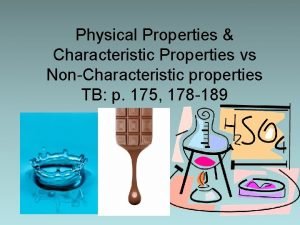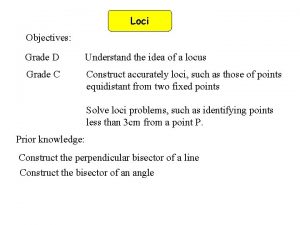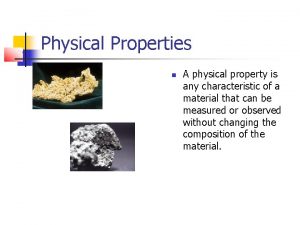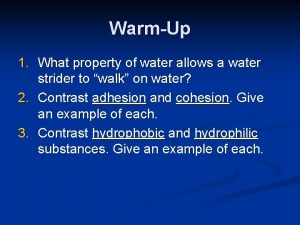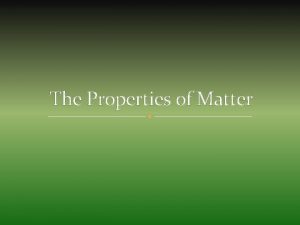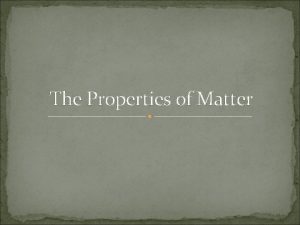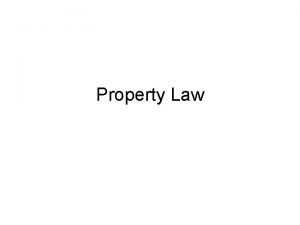WarmUp Property Any characteristic that allows us to







































- Slides: 39

Warm-Up Property: Any characteristic that allows us to recognize a particular type of matter and distinguish it from other types of matter. Why do you think it is important for matter to have properties and for us to know what those properties are?

Homework Check Open your notebook to your Venn Diagram & Vocabulary Tables – I will check them throughout the class period. If you want to turn them in, you may put them in the Inbox. If you have a syllabus signature, turn it in to your Inbox. If you have corrected homework/labs/quiz turn it in to your Inbox.

Objective Distinguish between physical and chemical properties and changes.

Review Matter: Anything that has mass and takes up space Matter can be classified as either a mixture or a pure substance

Types of Matter Substance - matter that is either an element or a compound. Cannot be separated by physical means. Mixture - a material made of elements or compounds mixed together, but not chemically combined. Can be separated by physical means.

Mixtures Homogeneous Black Coffee Flat Soda Sugar ** Water is not a homogeneous mixture. Why not? Heterogeneous Soil City Air Paint

Pure Substances Elements Iron Copper Hydrogen Compounds Water Hydrogen Peroxide Table salt (Na. Cl)

Properties of Matter

Physical/Chemical Changes and Properties Physical Property Chemical Property Physical Change Chemical Change

Properties A property is any characteristic that allows us to recognize a particular type of matter and distinguish it from other types.

Physical Property Can be observed without changing the composition of the substance.

Examples of Physical Properties • Color, shape, phase, texture, hardness, density, boiling point, melting point and odor.

2 Types of Physical Properties Intensive Properties Extensive Properties A physical property that is the same regardless of the amount of matter Examples: Density Color Conductivity Luster that will change if the amount of matter changes Examples: Mass Volume Length

Chemical Property Can only be observed by changing the composition of the substance.

Examples of Chemical Properties Acidity, p. H, combustibility, and reactivity.

Physical Change A change of matter in size, shape, or state without any change in identity or composition.

In other words……… • A physical change does not change what the substance is or what it is made of.

Chemical Change • The change of a substance into a new and different substance. • NEW SUBSTANCES ARE FORMED • Also known as a chemical reaction

Summary


Choose a Corner For the following examples, you will decide whether the change is Physical or Chemical YOU MUST WALK TO THE CORNER THAT REPRESENTS YOUR ANSWER Be prepared to support your answer

Dissolving sugar in water PHYSICAL

Burning gasoline CHEMICAL

Bread Rising CHEMICAL

Boiling water PHYSICAL

Sun Tanning CHEMICAL

Whipping Egg Whites PHYSICAL

Magnetizing a compass needle PHYSICAL

Milk souring CHEMICAL

Dicing potatoes PHYSICAL

Dissolving Alka-Seltzer in water CHEMICAL

Cooking eggs CHEMICAL

Digestion CHEMICAL

Jewelry Tarnishing CHEMICAL

Rubbing alcohol evaporates PHYSICAL

Lighting a match CHEMICAL

Closure Before you leave…list 1 thing you learned today 1 question you still have about physical and chemical properties and/or physical and chemical changes Homework: Due Sept 6 th Finish the worksheet for physical vs chemical properties Finish the worksheet for physical vs chemical changes

Poster Define: Chemical Property Physical Property Chemical Change Physical Change Give an example of each one Can be an image or write the word

 Any characteristic of a material that can be observed
Any characteristic of a material that can be observed Thơ thất ngôn tứ tuyệt đường luật
Thơ thất ngôn tứ tuyệt đường luật Tôn thất thuyết là ai
Tôn thất thuyết là ai Phân độ lown
Phân độ lown Chiến lược kinh doanh quốc tế của walmart
Chiến lược kinh doanh quốc tế của walmart Gây tê cơ vuông thắt lưng
Gây tê cơ vuông thắt lưng Block av độ 2
Block av độ 2 Tìm vết của mặt phẳng
Tìm vết của mặt phẳng Sau thất bại ở hồ điển triệt
Sau thất bại ở hồ điển triệt Thể thơ truyền thống
Thể thơ truyền thống Con hãy đưa tay khi thấy người vấp ngã
Con hãy đưa tay khi thấy người vấp ngã Warmup ratio
Warmup ratio Warmup end
Warmup end Mind rhyming words
Mind rhyming words Pathos story
Pathos story Warmup 65
Warmup 65 Multiplication properties of exponents
Multiplication properties of exponents Tinman endurance coaching
Tinman endurance coaching Gmass warmup
Gmass warmup Java warmup
Java warmup Warmup 65
Warmup 65 Surface area warm up
Surface area warm up Status vs class
Status vs class Define:warmup
Define:warmup Non characteristic properties examples
Non characteristic properties examples Characteristic physical property
Characteristic physical property Any to any connectivity
Any to any connectivity Seknder
Seknder No there aren't
No there aren't Sapratibandha daya and apratibandha daya
Sapratibandha daya and apratibandha daya Physical property and chemical property
Physical property and chemical property Associative property vs commutative property
Associative property vs commutative property Roles of first aid
Roles of first aid Network that allows several lans to be connected is
Network that allows several lans to be connected is Trackball and thumbwheels
Trackball and thumbwheels What is the disadvantage of direct mapping
What is the disadvantage of direct mapping The locus of points idea allows
The locus of points idea allows Chapter 9 review stoichiometry
Chapter 9 review stoichiometry Reading strategies synthesizing
Reading strategies synthesizing Mutable and immutable files in distributed system
Mutable and immutable files in distributed system
























